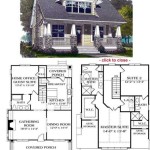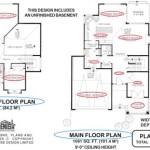Create The Home Of Your Dreams: House Plans And Floor Plans
Designing a home represents a significant undertaking, requiring careful consideration of individual needs, desired aesthetics, and practical functionality. The cornerstone of any successful home building or renovation project lies in meticulous house plans and floor plans. These documents serve as blueprints, guiding the entire construction process and ensuring the final product aligns with the homeowner's vision. Understanding the nuances of house plans and floor plans is crucial for anyone embarking on this journey, enabling informed decision-making and minimizing potential errors.
House plans encompass a comprehensive set of drawings, specifications, and related documents that detail all aspects of a proposed dwelling. They provide a visual representation of the house, outlining its dimensions, layout, materials, and construction methods. Floor plans, a subset of house plans, specifically focus on the arrangement of rooms within each level of the house. They illustrate the size and shape of each room, the location of doors and windows, and the placement of essential fixtures such as plumbing and electrical outlets.
Effective house plans and floor plans are essential for several reasons. First, they facilitate clear communication between the homeowner, architect, builder, and other contractors involved in the project. By providing a shared understanding of the design, they minimize misunderstandings and ensure that everyone is working towards the same goal. Second, they aid in accurate cost estimation. Detailed plans allow builders to calculate material requirements and labor costs with greater precision, reducing the likelihood of budget overruns. Third, they enable informed decision-making throughout the construction process. Homeowners can visualize the finished product and make changes to the design before construction begins, saving time and money in the long run. Finally, well-designed plans ensure code compliance. Architects and builders must adhere to local building codes and regulations, and house plans serve as evidence of compliance.
Key Point 1: Understanding the Components of House Plans
House plans are not a single document but rather a collection of drawings and specifications that provide a complete picture of the proposed house. Several key components make up a comprehensive set of house plans:
Site Plan: This plan illustrates the location of the house on the property, showing property lines, setbacks, easements, and the location of utilities. It also indicates the orientation of the house in relation to the sun and prevailing winds, which can be important for energy efficiency. The site plan also includes information about landscaping, driveways, and other exterior features.
Floor Plans: As mentioned earlier, floor plans depict the layout of each level of the house, showing the size and shape of rooms, the location of doors and windows, and the placement of fixtures. They also indicate the dimensions of walls and other structural elements. Floor plans are typically drawn to scale, allowing for accurate measurements.
Elevations: These drawings show the exterior appearance of the house from different viewpoints, typically the front, rear, and sides. Elevations illustrate the roofline, window and door styles, and exterior finishes. They provide a visual representation of the house's architectural style and overall aesthetic.
Sections: Section drawings provide a cutaway view of the house, showing the relationship between different floors and the internal construction of walls and roofs. They illustrate the structural components of the house and the location of insulation, plumbing, and electrical wiring.
Foundation Plan: This plan details the construction of the foundation, including the type of foundation (e.g., slab, crawl space, basement), the dimensions of the footings, and the location of any supporting walls or piers. The foundation plan is critical for ensuring the structural integrity of the house.
Roof Plan: This plan illustrates the shape and slope of the roof, showing the location of ridges, valleys, and eaves. It also specifies the type of roofing material to be used. The roof plan is important for ensuring proper drainage and preventing leaks.
Electrical Plan: The electrical plan shows the location of electrical outlets, switches, light fixtures, and the electrical panel. It also indicates the wiring routes and the size of the electrical service. This plan ensures safe and efficient electrical distribution throughout the house.
Plumbing Plan: This plan illustrates the location of plumbing fixtures, such as sinks, toilets, showers, and bathtubs, as well as the location of water pipes and drain lines. It also indicates the size and type of plumbing materials to be used. The plumbing plan ensures proper water supply and waste disposal.
Mechanical Plan: The mechanical plan shows the location of heating, ventilation, and air conditioning (HVAC) equipment, as well as the ductwork and piping associated with these systems. It ensures efficient and comfortable climate control throughout the house.
Details: Detail drawings provide enlarged views of specific construction elements, such as window and door frames, staircases, and cabinetry. They illustrate the precise dimensions and construction methods for these elements.
Specifications: These written documents provide detailed information about the materials, finishes, and construction methods to be used in the project. They cover everything from the type of lumber to the brand of paint.
Key Point 2: Choosing the Right Floor Plan Layout
The floor plan is arguably the most important aspect of house plans because it directly impacts the functionality and livability of the home. A well-designed floor plan will maximize space utilization, promote efficient traffic flow, and create a comfortable and inviting atmosphere. Several factors should be considered when selecting or designing a floor plan:
Lifestyle: Consider the lifestyle of the occupants. How do they spend their time at home? Do they entertain frequently? Do they work from home? Do they have young children or elderly relatives living with them? The floor plan should accommodate their specific needs and preferences.
Family Size: The size of the family will also impact the choice of floor plan. Larger families will require more bedrooms and bathrooms, as well as larger living areas. Smaller families may be able to get by with a more compact floor plan.
Budget: The budget is a major constraint on the design. Larger and more complex floor plans will typically cost more to build. It is important to find a floor plan that meets the needs of the occupants without exceeding the budget.
Lot Size and Shape: The size and shape of the lot will also influence the choice of floor plan. Narrow lots, for example, may require a long and narrow house design. Sloping lots may require a split-level or hillside design.
Orientation: The orientation of the house in relation to the sun can have a significant impact on energy efficiency. A well-oriented house will take advantage of natural sunlight for heating and lighting, reducing energy costs.
Traffic Flow: The floor plan should promote efficient traffic flow, with easy access to all areas of the house. Avoid creating bottlenecks or dead ends. The kitchen should be easily accessible from the dining area and the living room. Bedrooms should be located away from noisy areas of the house.
Privacy: The floor plan should provide adequate privacy for all occupants. Bedrooms should be located away from public areas of the house. Bathrooms should be easily accessible from bedrooms.
Space Utilization: The floor plan should maximize space utilization, avoiding wasted space. Rooms should be appropriately sized for their intended use. Consider using open floor plans to create a more spacious feel.
Several common floor plan layouts exist, each with its own advantages and disadvantages. Some popular layouts include:
Ranch: Ranch-style homes are typically single-story and feature an open floor plan. They are easy to navigate and are well-suited for families with young children or elderly relatives.
Two-Story: Two-story homes offer more living space on a smaller footprint. They are often more energy-efficient than ranch-style homes. However, they require stairs, which may be a concern for some families.
Split-Level: Split-level homes feature multiple levels connected by short flights of stairs. They are well-suited for sloping lots and can provide a good separation of living areas.
Open Concept: Open concept layouts typically combine the kitchen, dining, and living areas into one large space. This creates a more spacious and social atmosphere.
Key Point 3: Working with Architects and Designers
While it is possible to find pre-designed house plans online or in books, working with a qualified architect or designer offers significant advantages. Architects and designers possess the expertise and experience to create custom house plans that perfectly meet the individual needs and preferences of the homeowner.
Benefits of Hiring an Architect or Designer:
Custom Design: Architects and designers can create a custom design that is tailored to the homeowner's specific needs, lifestyle, and budget. They can also incorporate unique architectural features and details that are not found in pre-designed plans.
Expertise and Experience: Architects and designers have extensive knowledge of building codes, construction methods, and materials. They can ensure that the house plans are accurate, complete, and compliant with all applicable regulations.
Problem Solving: Architects and designers are skilled problem solvers. They can identify and address potential design challenges before they become costly construction problems.
Project Management: Many architects and designers offer project management services, overseeing the construction process and ensuring that the project stays on schedule and within budget.
Increased Property Value: A well-designed and professionally built house can significantly increase the value of the property.
Finding the Right Architect or Designer:
Referrals: Ask friends, family, and colleagues for referrals. Check online reviews and testimonials.
Portfolio: Review the architect's or designer's portfolio to see examples of their work. Look for projects that are similar in style and scope to your own.
Interview: Interview several architects or designers to discuss your project and their approach to design. Make sure you feel comfortable working with them and that they understand your vision.
Contract: Before hiring an architect or designer, be sure to sign a written contract that outlines the scope of services, the fees, and the payment schedule.
Effective communication with the architect or designer is crucial for a successful project. Be prepared to provide them with detailed information about your needs, preferences, and budget. Review the house plans carefully and ask questions about anything you don't understand. Provide feedback throughout the design process to ensure that the final product meets your expectations.
Crafting personalized house plans and floor plans necessitates meticulous attention to detail, a thorough comprehension of individual requirements, and the integration of both aesthetic preferences and practical functionality. Whether selecting pre-designed blueprints or engaging with an architect for a bespoke design, prioritizing clarity, precision, and adherence to construction standards is paramount. By investing time and resources in the planning stage, homeowners can lay a sturdy foundation for creating the home they've always envisioned.

5 Tips To Build Your Dream Home And Stay On Budget Dfd House Plans Blog

Build Your Dream House Inspired By This Modern Design Cool Concepts

How To Design A Home 7 Steps Your Dream Foyr

Make Your Dream House Floor Plans By Architect Rehan Fiverr

Build Your Dream House Inspired By This Modern Design Cool Concepts

How To Design Your Dream House Edrawmax

Makemyhouse Com Helps You With All Your Planning And Design Of Dream House The Property Times Real Estate News Views Portal

Create A Floorplan To Your Dream House In 24 Hours By Wowowen19 Fiverr

How To Design A Home 7 Steps Your Dream Foyr

One Y Dream Home Php 2024036 1s Pinoy House Plans
Related Posts








